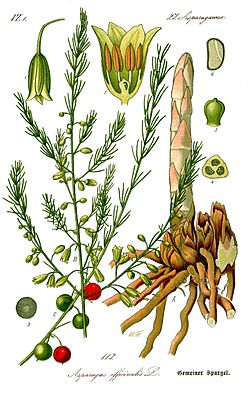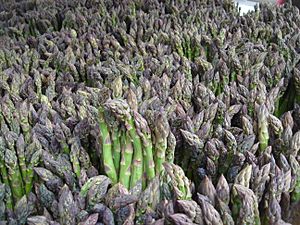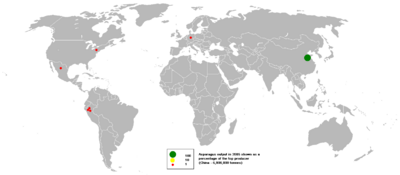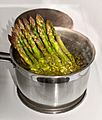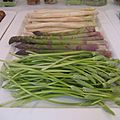Garden asparagus facts for kids
Quick facts for kids Asparagus |
|
|---|---|
 |
|
| Asparagus officinalis plants. | |
| Scientific classification | |
| Kingdom: | |
| Division: | |
| Class: | |
| Order: | |
| Family: | |
| Genus: |
Asparagus
|
Asparagus is a large genus of flowering plants with over 300 different species. Some of the plants are grown as ornamental plants. One of these is the "asparagus fern", Asparagus setaceus, which is not a real fern. The best known plant in this group is Asparagus officinalis, which is grown as a vegetable, and is usually eaten in spring.
Some species of asparagus are used in cooking.
Contents
Uses
| Nutritional value per 100 g (3.5 oz) | |
|---|---|
| Energy | 85 kJ (20 kcal) |
|
3.88 g
|
|
| Sugars | 1.88 g |
| Dietary fibre | 2.1 g |
|
0.12 g
|
|
|
Protein
|
2.2 g
|
| Vitamins | Quantity
%DV†
|
| Vitamin A equiv.
beta-Carotene
lutein zeaxanthin
|
5%
38 μg
4%
449 μg710 μg
|
| Thiamine (B1) |
12%
0.143 mg |
| Riboflavin (B2) |
12%
0.141 mg |
| Niacin (B3) |
6%
0.978 mg |
| Pantothenic acid (B5) |
5%
0.274 mg |
| Vitamin B6 |
7%
0.091 mg |
| Folate (B9) |
13%
52 μg |
| Choline |
3%
16 mg |
| Vitamin C |
7%
5.6 mg |
| Vitamin E |
7%
1.1 mg |
| Vitamin K |
40%
41.6 μg |
| Minerals | Quantity
%DV†
|
| Calcium |
2%
24 mg |
| Iron |
16%
2.14 mg |
| Magnesium |
4%
14 mg |
| Manganese |
8%
0.158 mg |
| Phosphorus |
7%
52 mg |
| Potassium |
7%
202 mg |
| Sodium |
0%
2 mg |
| Zinc |
6%
0.54 mg |
|
Link to USDA Database entry
|
|
| †Percentages estimated using US recommendations for adults. | |
Only young asparagus shoots are commonly eaten: once the buds start to open ("ferning out"), the shoots quickly turn woody.
Water makes up 93% of asparagus's composition. Asparagus is low in calories and is very low in sodium. It is a good source of vitamin B6, calcium, magnesium, and zinc, and a very good source of dietary fibre, protein, beta-carotene, vitamin C, vitamin E, vitamin K, thiamin, riboflavin, rutin, niacin, folic acid, iron, phosphorus, potassium, copper, manganese, and selenium, as well as chromium, a trace mineral that enhances the ability of insulin to transport glucose from the bloodstream into cells. The amino acid asparagine gets its name from asparagus, as the asparagus plant is relatively rich in this compound.
The shoots are prepared and served in a number of ways around the world, typically as an appetizer or vegetable side dish. In Asian-style cooking, asparagus is often stir-fried. Cantonese restaurants in the United States often serve asparagus stir-fried with chicken, shrimp, or beef. It may also be quickly grilled over charcoal or hardwood embers, and is also used as an ingredient in some stews and soups. In recent years, asparagus eaten raw, as a component of a salad, has regained popularity.
Asparagus can also be pickled and stored for several years. Some brands label shoots prepared in this way as "marinated".
Stem thickness indicates the age of the plant, with the thicker stems coming from older plants. Older, thicker stalks can be woody, although peeling the skin at the base removes the tough layer. Peeled asparagus will poach much faster. The bottom portion of asparagus often contains sand and soil, so thorough cleaning is generally advised before cooking.
Green asparagus is eaten worldwide, though the availability of imports throughout the year has made it less of a delicacy than it once was. In Europe, however, the "asparagus season is a highlight of the foodie calendar"; in the UK this traditionally begins on 23 April and ends on Midsummer Day. As in continental Europe, due to the short growing season and demand for local produce, asparagus commands a premium price.
White asparagus in continental northwestern Europe
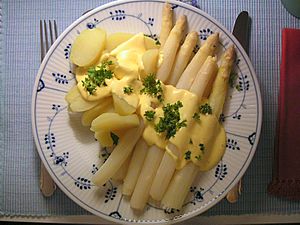
Asparagus is very popular in the Netherlands, Spain, France, Poland, Belgium, Germany, Austria, Turkey, Italy, and Switzerland, and is almost exclusively white; if not, it is specified by the local language term for "green asparagus". White asparagus is the result of applying a blanching technique while the asparagus shoots are growing. To cultivate white asparagus, the shoots are covered with soil as they grow, i.e. earthed up; without exposure to sunlight, no photosynthesis starts, and the shoots remain white. Compared to green asparagus, the locally cultivated so-called "white gold" or "edible ivory" asparagus, also referred to as "the royal vegetable", is believed to be less bitter and much more tender. Freshness is very important, and the lower ends of white asparagus must be peeled before cooking or raw consumption.
Only seasonally on the menu, asparagus dishes are advertised outside many restaurants, usually from late April to June. For the French style, asparagus is often boiled or steamed and served with Hollandaise sauce, melted butter or olive oil, Parmesan cheese, or mayonnaise. Tall, narrow asparagus cooking pots allow the shoots to be steamed gently, their tips staying out of the water.
Cultivation
Since asparagus often originates in maritime habitats, it thrives in soils that are too saline for normal weeds to grow. Thus, a little salt was traditionally used to suppress weeds in beds intended for asparagus; this has the disadvantage that the soil cannot be used for anything else. Some places are better for growing asparagus than others. The fertility of the soil is a large factor. "Crowns" are planted in winter, and the first shoots appear in spring; the first pickings or "thinnings" are known as sprue asparagus. Sprue has thin stems.
A breed of "early season asparagus" that can be harvested two months earlier than usual was announced by a UK grower in early 2011. This variety does not need to lie dormant and blooms at 7 °C (45 °F) rather than the usual 9 °C (48 °F).
Purple asparagus differs from its green and white counterparts in having high sugar and low fibre levels. Purple asparagus was originally developed in Italy, near the city of Albenga and commercialized under the variety name 'Violetto d' Albenga'. Since then, breeding work has continued in the United States and New Zealand, creating the 'Pacific Purple' variety.
Companion planting
Asparagus is said to be a useful companion plant for tomatoes, as the tomato plant repels the asparagus beetle. Asparagus may repel some harmful root nematodes that affect tomato plants.
Commercial production
The top asparagus importers (2013) were the United States (182,805 tonnes), followed by the European Union (external trade) (94,475 tonnes), and Canada (20,219 tonnes).
China is by far the world's largest producer: in 2013 it produced 7,000,000 tonnes, followed by Peru with 383,144 tonnes and Mexico with 126,421 tonnes. U.S. production was concentrated in California, Michigan, and Washington. The annual production for white asparagus in Germany is 57,000 tonnes (61% of consumer demand).
When growing under tunnels, growers can increase the growth season. In Britain, it is estimated that the harvest season of asparagus grown under tunnels can be from February to November.
Images for kids
-
Three types of asparagus are on display, with white asparagus at the back and green asparagus in the middle. The plant at the front is Ornithogalum pyrenaicum, commonly called wild asparagus, and sometimes "Bath asparagus".
-
Wild asparagus (Asparagus aphyllus) native to the Levant
-
Mature wild asparagus with seed pods in Saskatchewan, Canada
See also
 In Spanish: Asparagus officinalis para niños
In Spanish: Asparagus officinalis para niños


